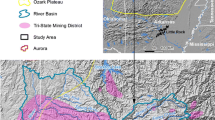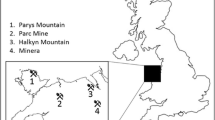Abstract
The UK is legally required by the EU Water Framework Directive (WFD) to improve the environmental quality of inland and coastal waters in the coming years. Historic metal mine sites are recognised as an important source of some of the elements on the WFD priority chemicals list. Despite their contamination potential, such sites are valued for their heritage and for other cultural and scientific reasons. Remediating historic mining areas to control the contamination of stream waters, whilst also preserving the integrity of the mine site, is a challenge but might be achieved by novel forms of remediation. In this study, we have carried out environmental monitoring at a historic, and culturally-sensitive, lead–silver mine site in southwest England and have undertaken a pilot experiment to investigate the potential for a novel, non-invasive remediation method at the site. Concentrations of Pb and Zn in mine spoil were clearly elevated with geometric mean concentrations of 6,888 and 710 μg g−1, respectively. Mean concentrations of Pb in stream waters were between 21 and 54 μg l−1, in exceedance of the WFD environmental quality standard (EQS) of 7.2 μg l−1 (annual average). Mean Zn concentrations in water were between 30 and 97 μg l−1, compared to the UK EQS of 66.5 μg l−1 (average). Stream sediments within, and downstream from, the mining site were similarly elevated, indicating transport of mine waste particles into and within the stream. We undertook a simple trial to investigate the potential of hydroxyapatite, in the form of bonemeal, to passively remove the Pb and Zn, from the stream waters. After percolating through bonemeal in a leaching column, 96–99% of the dissolved Pb and Zn in stream water samples was removed.
Similar content being viewed by others
References
Archer, M. J. G., & Caldwell, R. A. (2004). Response of six Australian plant species to heavy metal contamination at an abandoned mine site. Water, Air, and Soil Pollution, 157, 257–267.
Barnatt, J., & Penny, R. (2004). The lead legacy: the prospects for the peak district’s lead mining heritage. UK: The Peak District National Park Authority, English Heritage, English Nature.
Booker, F. (1971). The Industrial Archaeology of the Tamar Valley. Newton Abbott: David & Charles.
Commission of the European Communities (2006). Proposal for a Directive of the European Parliament and the Council on Environmental Quality Standards in the Field of Water Policy and Amending Directive 200/60/EC. Commission of the European Communities, Brussels.
Conesa, H. M., Schulin, R., & Nowack, B. (2007). Mining landscape: a cultural tourist opportunity or an environmental problem? Ecological Economics. In press.
DEFRA (Department of Environment, Food and Rural Affairs) (2002). The contaminated land exposure assessment model (CLEA): technical basis and algorithms. UK: R&D CLR10.
Environment Agency Wales (2003). Lime dosing to restore the upper Towy. UK: Carmarthenshire Fishermens’ Federation. http://www.carmarthenshire.org.uk/Llyn%Brianne%20Reservoir/lime_dosers.htmd.
European Environment Agency (2004). Indicator fact sheet: hazardous substances in rivers. http://themes.eea.eu.int/Specific_media/water/indicators/WHS02%2C2004.05/WHS2_HazardousSubstancesRivers_180504.pdf.
Harris, H. (1992). The industrial archaeology of Dartmoor. Newton Abbott: Peninsula.
Hodson, M. E., Valsami-Jones, E., & Cotter-Howells, J. D. (2000). Bonemeal additions as a remediation treatment for metal contaminated soil. Environmental Science and Technology, 34, 3501–3507.
Interdepartmental Committee on the Redevelopment of Contaminated Land (ICRCL) (1987). Guidance on the assessment and redevelopment of contaminated land, guidance note 59/83. London: Department of the Environment.
Jarvis, A. P., Moustafa, A., Orme, P. H. A., & Younger, P. L. (2006). Effective remediation of grossly polluted acidic, and metal-rich, spoil heap drainage using a novel, low-cost, permeable reactive barrier in Northumberland, UK. Environmental Pollution, 143, 261–268.
Kabata-Pendias, A. (2000). Trace elements in soils and plants. Boca Raton: CRC.
Lessmark, O., & Thornelof, E. (1986). Liming in Sweden. Water, Air, and Soil Pollution, 31, 809–815.
Ma, Q. Y., Traina, S. J., & Logan, T. J. (1993). In situ lead immobilisation by apatite. Environmental Science and Technology, 27, 1803–1810.
Nriagu, J. O. (1974). Lead orthophosphates. IV. Formation and stability in the environment. Geochimica et cosmochimica acta, 38, 887–898.
OSPAR Commission (2000). Quality status report for the North East Atlantic. London: OSPAR Commission.
Pirrie, D., Power, M. R., Rollinson, G., Camm, G. S., Hughes, S. H., Butcher, A. R., et al. (2003). The spatial distribution and source of arsenic, copper, tin and zinc within the surface sediments of the Fal Estuary, Cornwall, UK. Sedimentology, 50, 579–595.
Smith, R. A. H., & Bradshaw, A. D. (1979). The use of metal tolerant plant populations for the reclamation of metalliferous wastes. Journal of Applied Ecology, 16, 595–612.
South West Environmental Observatory (2003). State of the environment report 2003. Exeter: South West Environmental Observatory.
UNESCO World Heritage Committee (2006). Decisions of the 30th session of the World Heritage Committee, Vilnius, 2006. Paris: UNESCO World Heritage Centre.
Webb, J. S., Thornton, I., Howarth, R. J., Thompson, M., & Lowenstein, P. L. (1978). The Wolfson Geochemical Atlas of England and Wales. Oxford: OUP.
Zhang, P., Ryan, J. A., & Yang, J. (1998). In vitro soil solubility in the presence of hydroxyapatite. Environmental Science and Technology, 32, 2763–2768.
Author information
Authors and Affiliations
Corresponding author
Rights and permissions
About this article
Cite this article
Rieuwerts, J.S., Austin, S. & Harris, E.A. Contamination from historic metal mines and the need for non-invasive remediation techniques: a case study from Southwest England. Environ Monit Assess 148, 149–158 (2009). https://doi.org/10.1007/s10661-007-0146-9
Received:
Accepted:
Published:
Issue Date:
DOI: https://doi.org/10.1007/s10661-007-0146-9




